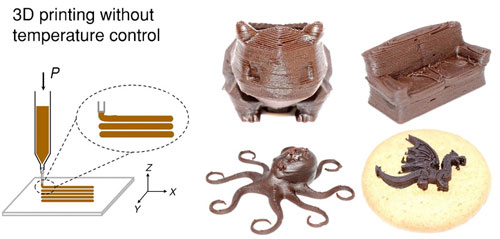| Oct 31, 2019 |
3D printing chocolate without temperature control
|
|
(Nanowerk News) Researchers from the Singapore University of Technology and Design (SUTD) have pioneered a novel approach to 3D print chocolate-based products at room temperature by cold extrusion.
|
|
The hot-melt extrusion method is widely used in 3D printed chocolates where the chocolate is required to be between the temperatures of 31 °C to 36 °C so that it can be melted and dispensed accordingly. While this method has its advantages in simplicity and accessibility, the narrow range of operating temperature can be highly restrictive and inflexible.
|
|
Conversely, cold extrusion does not require the manipulation of temperature as it depends solely on the rheology of printing ink that is added to chocolate at the operating temperature. However, due to the lack of inks possessing suitable rheological properties, cold extrusion in 3D printed chocolate has not been demonstrated to date.
|
|
To bridge this gap, researchers from SUTD's Soft Fluidics Lab developed a new approach, ‘Chocolate-based Ink 3D Printing’ (Ci3DP), to print chocolate-based inks at room temperature by cold extrusion (Scientific Reports, "Chocolate-based Ink Three-dimensional Printing (Ci3DP)").
|
 |
| Concept of chocolate-based ink 3D printing (Ci3DP) involves liquid chocolate products mixed with edible additives and printed by a direct ink writing (DIW) 3D printer at room temperature. The formulated inks allowed easy extrusion through the syringes and nozzles and form self-supporting layers after extrusion to maintain the printed structures. (click on image to enlarge)
|
|
Using the Ci3DP approach, readily available chocolate products such as syrups and pastes were mixed with cocoa powder to alter the rheology of the ink. Chocolate-based inks with high concentrations of cocoa powders exhibited shear-thinning properties with high viscosity; the inks also possessed a toothpaste-like property that did not flow at rest.
|
|
To highlight this capability, 3D models consisting of chocolate syrups and pastes were demonstrated. The same method was extended to the fabrication of a chocolate with different textures by using multiple types of inks. For instance, a piece of chocolate was fabricated with a semi-solid enclosure and liquid filling at the same time, further demonstrating the flexibility that this approach provides.
|
|
“The simplicity and flexibility of Ci3DP offer great potential in fabricating complex chocolate-based products without the need for temperature control,” said lead author of the research paper, Dr Rahul Karyappa from SUTD.
|
|
Principal investigator, Assistant Professor Michinao Hashimoto from SUTD added, “Ci3DP is capable of fabricating customized food in a wide range of materials with tailored textures and optimized nutritional content. This new approach also widens the industry’s capabilities in 3D food printing, allowing for the cold-extrusion of food products that are temperature-sensitive.”
|

